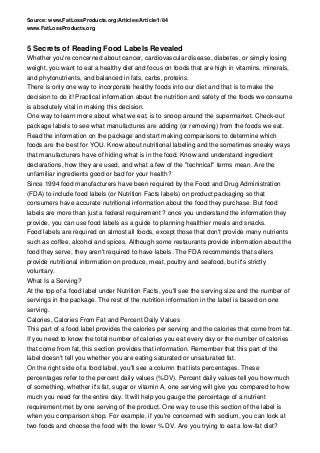
5 secrets of reading food labels revealed
- 1. Source: www.FatLossProducts.org/Articles/Article/1/84 www.FatLossProducts.org 5 Secrets of Reading Food Labels Revealed Whether you're concerned about cancer, cardiovascular disease, diabetes, or simply losing weight, you want to eat a healthy diet and focus on foods that are high in vitamins, minerals, and phytonutrients, and balanced in fats, carbs, proteins. There is only one way to incorporate healthy foods into our diet and that is to make the decision to do it! Practical information about the nutrition and safety of the foods we consume is absolutely vital in making this decision. One way to learn more about what we eat, is to snoop around the supermarket. Check-out package labels to see what manufactures are adding (or removing) from the foods we eat. Read the information on the package and start making comparisons to determine which foods are the best for YOU. Know about nutritional labeling and the sometimes sneaky ways that manufacturers have of hiding what is in the food. Know and understand ingredient declarations, how they are used, and what a few of the "technical" terms mean. Are the unfamiliar ingredients good or bad for your health? Since 1994 food manufacturers have been required by the Food and Drug Administration (FDA) to include food labels (or Nutrition Facts labels) on product packaging so that consumers have accurate nutritional information about the food they purchase. But food labels are more than just a federal requirement ? once you understand the information they provide, you can use food labels as a guide to planning healthier meals and snacks. Food labels are required on almost all foods, except those that don't provide many nutrients such as coffee, alcohol and spices. Although some restaurants provide information about the food they serve, they aren't required to have labels. The FDA recommends that sellers provide nutritional information on produce, meat, poultry and seafood, but it's strictly voluntary. What Is a Serving? At the top of a food label under Nutrition Facts, you'll see the serving size and the number of servings in the package. The rest of the nutrition information in the label is based on one serving. Calories, Calories From Fat and Percent Daily Values This part of a food label provides the calories per serving and the calories that come from fat. If you need to know the total number of calories you eat every day or the number of calories that come from fat, this section provides that information. Remember that this part of the label doesn't tell you whether you are eating saturated or unsaturated fat. On the right side of a food label, you'll see a column that lists percentages. These percentages refer to the percent daily values (%DV). Percent daily values tell you how much of something, whether it's fat, sugar or vitamin A, one serving will give you compared to how much you need for the entire day. It will help you gauge the percentage of a nutrient requirement met by one serving of the product. One way to use this section of the label is when you comparison shop. For example, if you're concerned with sodium, you can look at two foods and choose the food with the lower % DV. Are you trying to eat a low-fat diet?
- 2. Look for foods that have a lower percent daily value of fat. The %DV is based on how much or how little of the key nutrients you should eat whether you eat 2,000 or 2,500 calories a day. So if you eat a 2,000-calorie diet, you should eat less than 65 grams of fat in all the foods you eat for the day. If you're eating 12 grams of fat in your one serving of macaroni and cheese (remember that's one cup), you can calculate how much fat you have left for the day. You can use the bottom part of the food label in white to compare what you are eating to the % DV you're allowed for that nutrient, whether it's fat, sodium or fiber. If you need more or less than 2,000 or 2,500 calories, you'll need to adjust this accordingly. The information contained in this article is for educational purposes only and is not intended to medically diagnose, treat or cure any disease. Consult a health care practitioner before beginning any health care program. Emily Clark is editor at Lifestyle Health News and Medical Health News where you can find the most up-to-date advice and information on many medical, health and lifestyle topics.
